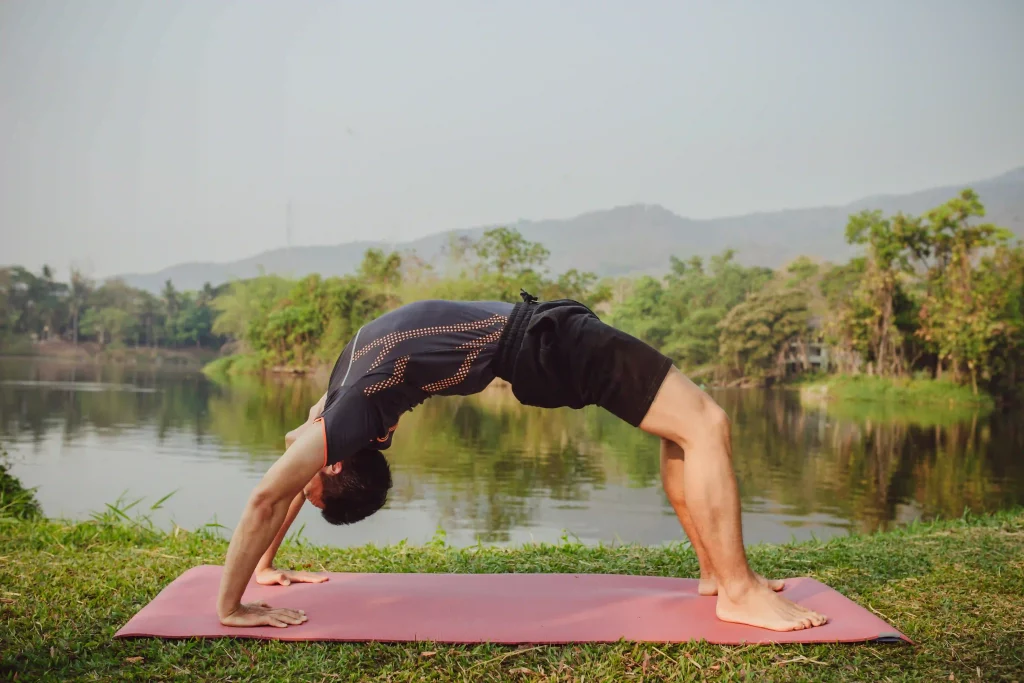Table of Contents
ToggleClassical Yoga is an ancient practice that originated in India thousands of years ago. It is a complete system that includes physical postures, breathing exercises, meditation, and ethical principles. The sage Patanjali codified Classical Yoga in the Yoga Sutras, which outline the eight-limbed path of yoga. The eight limbs include yama (moral codes), niyama (self-purification and study), asana (physical postures), pranayama (breath control), pratyahara (withdrawal of senses), dharana (concentration), dhyana (meditation), and samadhi (state of higher consciousness).
In today’s fast-moving world, where stress and anxiety are growing, Classical Yoga offers a holistic approach to wellness. It helps individuals find balance in their physical, mental, and spiritual lives. Regular practice of Classical Yoga can improve flexibility, strength, and overall physical health. It also helps individuals manage stress, improve concentration, and promote emotional well-being. Furthermore, Classical Yoga provides a framework for living a meaningful and purposeful life based on ethical principles and self-awareness.
In this blog, we will explore the history & practice of Classical Yoga. We will also examine the benefits of practicing Classical Yoga and offer tips for incorporating it into daily life. By the end of this article, we hope to inspire readers to embrace Classical Yoga as a valuable tool for achieving optimal health and well-being.
What is Classical Yoga
Classical Yoga is a traditional system of yoga philosophy and practice that aims to help individuals attain inner peace, spiritual growth, and self-realisation. This is achieved through various practices like physical postures, breathing exercises, concentration, meditation, and enlightenment. The Yoga Sutras of Patanjali is the authoritative text that outlines the eightfold path of yoga, which consists of ethical guidelines, self-discipline, physical postures, breathing techniques, withdrawal of senses, concentration, meditation, and enlightenment. Classical Yoga emphasises the importance of a healthy and balanced lifestyle, including a vegetarian diet, regular practice, and detachment from material possessions and worldly desires. It is a comprehensive system that helps bring harmony and balance to all aspects of a person’s life.
History and Philosophy of Classical Yoga:
The history of Classical Yoga dates back to ancient India, where it originated as a spiritual practice over 5,000 years ago. The earliest records of Yoga date back to the Indus Valley Civilisation. Over time, Yoga evolved into various forms, including Classical Yoga, which was codified by the sage Patanjali around 200-500 BCE.
The philosophy of Classical Yoga is based on the idea that the ultimate goal of human life is to achieve self-realisation and liberation (moksha). Patanjali outlined the eight-limbed path of Yoga, known as Ashtanga Yoga, as a means to attain this goal.
The 8 Limbs of Classical Yoga are:

- Yama – moral codes and ethical principles
- Niyama – self-purification and study
- Asana – physical postures
- Pranayama – breath control
- Pratyahara – withdrawal of senses
- Dharana – concentration
- Dhyana – meditation
- Samadhi – state of higher consciousness
These eight limbs are interdependent and progressive, with each stage building upon the previous one. They guide individuals towards self-awareness, self-discipline, and self-realisation. In Classical Yoga, the practice of physical postures (asanas), breathing exercises (pranayama), and meditation are used to prepare the body and mind for spiritual practice and self-realisation.
The concept of self-realisation in Classical Yoga is based on the idea that the individual self (jivatman) is connected to the universal self (paramatman). Through the practice of Classical Yoga, individuals can connect with their true selves and experience a sense of oneness with the universe.
Practice of Classical Yoga:
Classical Yoga is a complete system that includes various practices, each with its unique benefits. These practices aim to create a balance between the body, mind, and spirit and prepare the individual for spiritual realisation.
Classical Yoga Asanas or Poses
Asanas refer to the physical postures practised in Classical Yoga. They are designed to develop strength, flexibility, and balance in the body, improve physical health, and prepare the body for meditation. There are hundreds of asanas, each with specific benefits. Some of the popular asanas include:
- Tadasana (Mountain Pose)
- Uttanasana (Forward Bend)
- Virabhadrasana (Warrior Pose)
- Trikonasana (Triangle Pose)
- Bhujangasana (Cobra Pose)
- Sarvangasana (Shoulder Stand)
- Shavasana (Corpse Pose)
Tadasana/Mountain Pose – The Foundation of Yoga
Tadasana is a classical yoga asana. Mountain Tadasana, or simply Mountain Pose, is a yoga position where you stand up straight and strong, just like a mountain standing tall and firm.
Pranayama:
Pranayama refers to breathing exercises in Classical Yoga. These exercises help to improve the flow of prana (life force energy) in the body, increase oxygenation, and calm the mind. Some of the popular pranayama techniques include:
- Nadi Shodhana (Alternate Nostril Breathing)
- Kapalabhati (Skull Shining Breath)
- Bhramari (Bee Breath)
- Ujjayi (Ocean Breath)
- Sheetali (Cooling Breath)
Meditation:
Meditation is a key component of Classical Yoga. It involves training the mind to focus and concentrate, leading to greater self-awareness and inner peace. There are several meditation techniques in Classical Yoga, including:
- Chakra Meditation
- Mantra Meditation
- Vipassana Meditation
- Loving-Kindness Meditation
Yama and Niyama:
Yama and Niyama are the ethical principles of Classical Yoga. They provide a framework for living a meaningful and purposeful life based on self-discipline and self-awareness. The five Yamas include Ahimsa (non-violence), Satya (truthfulness), Asteya (non-stealing), Brahmacharya (celibacy), and Aparigraha (non-attachment). The five Niyamas include Saucha (cleanliness), Santosha (contentment), Tapas (self-discipline), Svadhyaya (self-study), and Ishvara Pranidhana (surrender to a higher power).
Developing a Regular Practice of Classical Yoga:
To develop a regular practice of Classical Yoga, it is essential to find a qualified teacher who can guide you through the practices. It is also important to start slowly and gradually increase the intensity of the practice. Setting aside regular time for practice and creating a peaceful environment can also help develop a consistent practice. Practising mindfulness, consistency, and dedication can lead to significant physical, mental, and spiritual benefits.
Benefits of Classical Yoga
The practice of Classical Yoga offers numerous benefits for physical, mental, and spiritual health. Here are some of the most commonly reported benefits:
- Improved Physical Health: Classical Yoga asanas help improve flexibility, strength, balance, and coordination. The practice can also increase cardiovascular health, reduce the risk of chronic diseases, and promote healthy digestion and metabolism.
- Reduced Stress and Anxiety: Regular practice of Classical Yoga can help reduce stress and anxiety by calming the mind and releasing tension in the body. Pranayama and meditation techniques are particularly effective in reducing stress levels.
- Increased Focus and Concentration: Meditation and pranayama practices can help increase mental clarity, focus, and concentration. This can improve productivity, performance, and creativity.
- Enhanced Spiritual Growth: The practice of Classical Yoga is based on the principle of self-realisation, which involves connecting with one’s inner self and realising the true nature of the self. This can lead to greater spiritual growth and a sense of purpose in life.
- Improved Sleep Quality: Classical Yoga practices can help improve the quality of sleep by reducing stress and promoting relaxation.
- Greater Emotional Balance: The practice of Yoga helps cultivate a greater sense of self-awareness and emotional balance. This can lead to more positive relationships, reduced anxiety and depression, and greater overall emotional well-being.
- Increased Sense of Community: Many people find that practising Yoga in a group setting creates a sense of community and social support, which can promote a greater sense of belonging and connection.
Overall, the benefits of Classical Yoga are numerous and can have a profound impact on physical, mental, and spiritual health. With regular practice and dedication, the benefits can be experienced over the long term.
Tips for integrating classical yoga into daily routine
Integrating Classical Yoga into your daily routine can be challenging, but here are some tips to help you get started:
- Start small: Begin with a short practice, even if it’s just five or ten minutes a day, and gradually increase the duration as you become more comfortable with the practice.
- Set aside a dedicated space: Designate a space in your home where you can practice Yoga without interruption. This will help create a peaceful and focused environment for your practice.
- Schedule your practice: Set a regular time for your Yoga practice each day and stick to it. This will help establish a routine and make your practice a habit.
- Mix it up: Try different practices, such as asanas, pranayama, and meditation, to keep your practice fresh and interesting.
- Use online resources: There are many online resources, such as videos and apps, that can help guide your practice and keep you motivated.
- Involve friends or family: Practice with friends or family members to make it a social activity and to hold each other accountable.
- Take it off the mat: Incorporate Yoga principles into your daily life, such as mindfulness and conscious breathing, to maintain a Yoga mindset even when you’re not practising on the mat.
By implementing these tips and making a commitment to your practice, you can integrate Classical Yoga into your daily routine and reap the many benefits it has to offer.
In conclusion, we have explored Classical Yoga, its history, philosophy, practices, and benefits. We have also provided tips on how to integrate Classical Yoga into daily routines, maintain motivation, and overcome obstacles. Classical Yoga is an ancient Indian practice that aims to achieve self-realization and liberation from suffering through various practices, such as asanas, pranayama, and meditation. Its principles and philosophy are outlined in the Yoga Sutras of Patanjali, and it has many benefits, including physical, mental, and emotional health.
If you’re interested in learning more about yoga or other aspects of Indian culture, you can visit the Hidden Mantra. There, you can find a wealth of articles and blog posts on various topics, including yoga, meditation, Ayurveda, and more. So, feel free to explore the blog to deepen your knowledge and understanding of Indian culture and its traditions.










2 Responses
Very informative Blog👍
We should living life with grateful. Experience sharing the great culture knowledge get inspired together